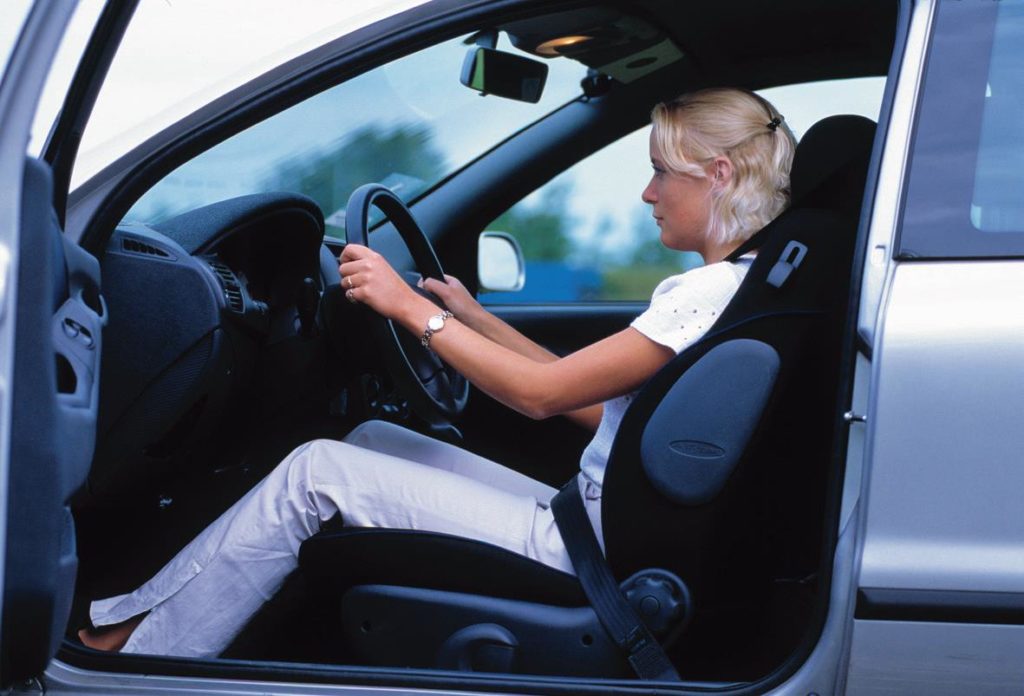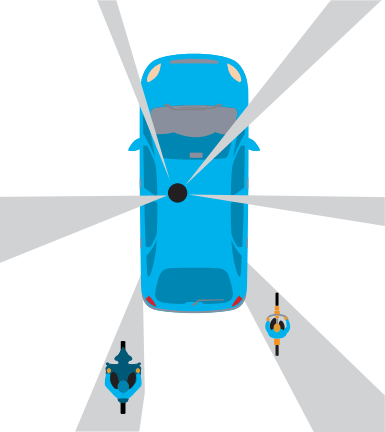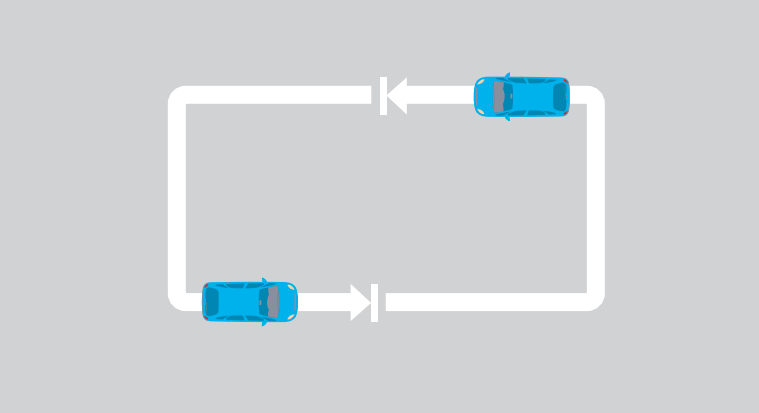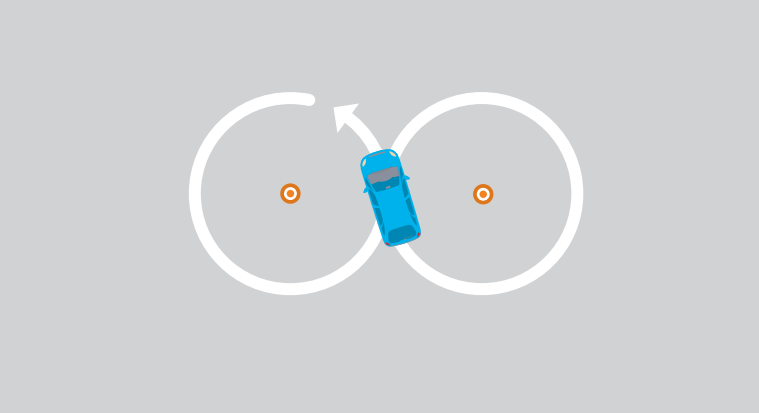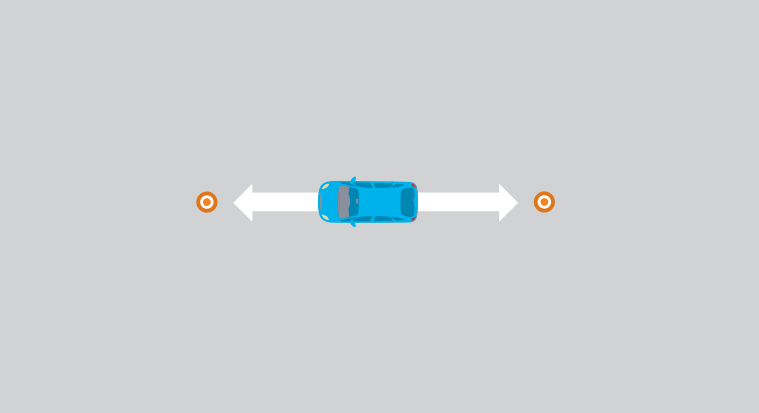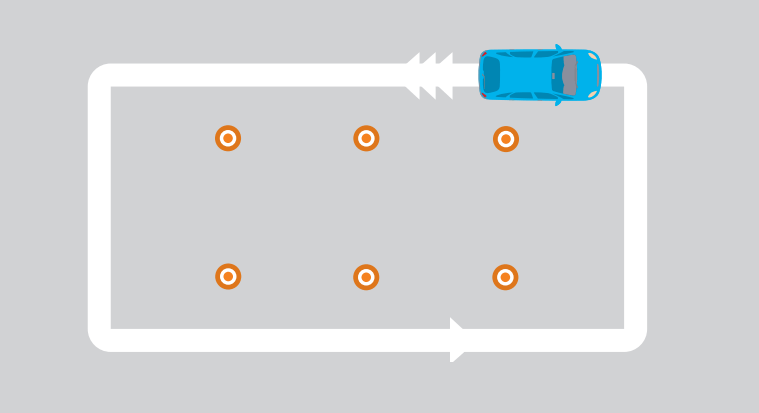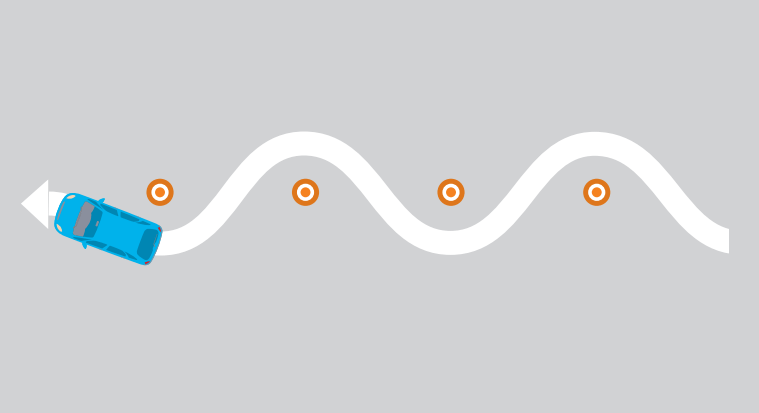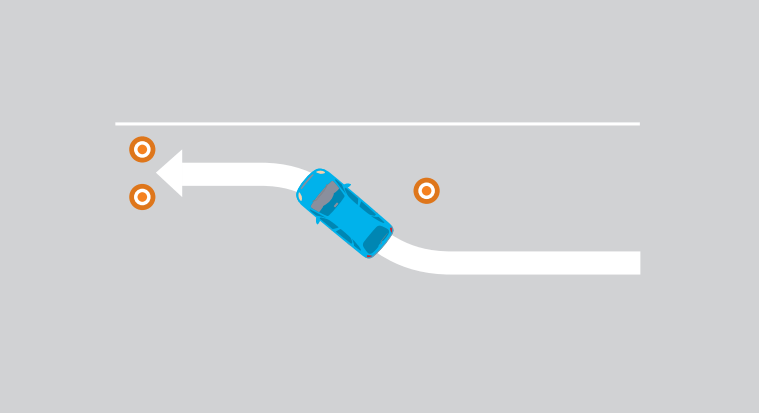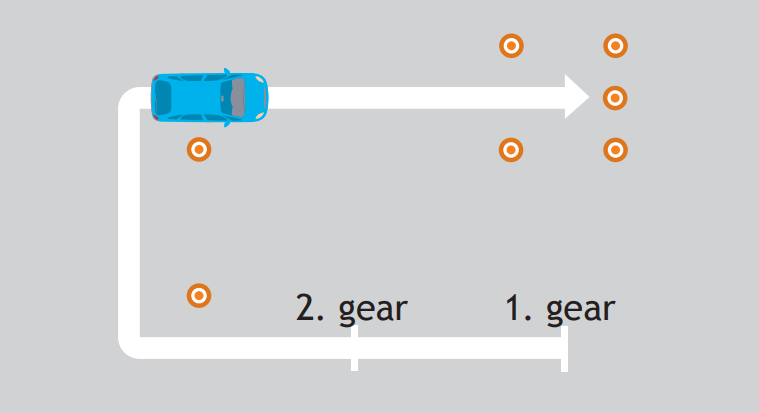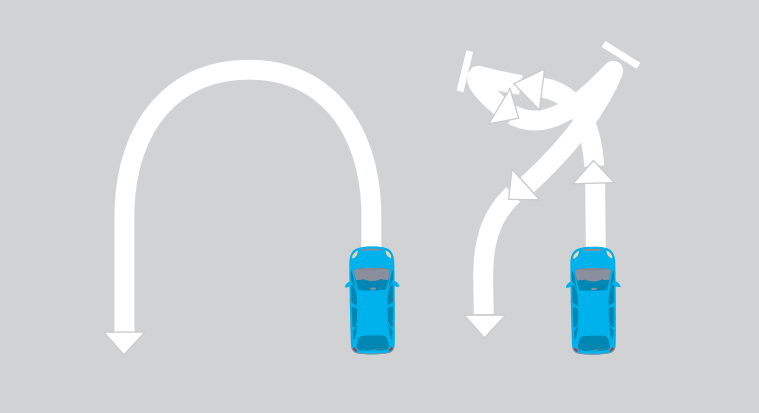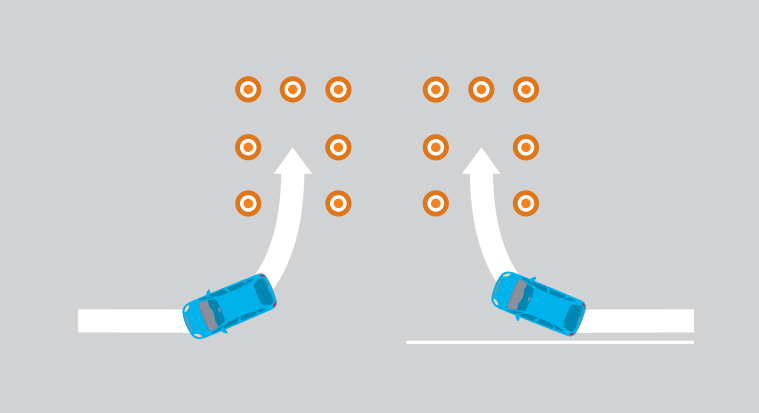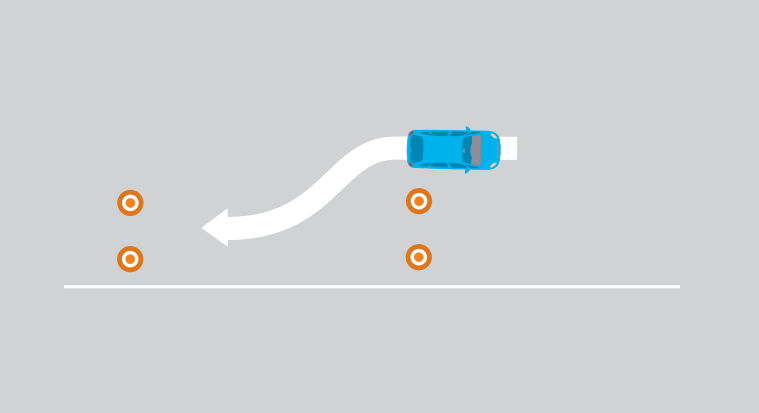Passenger car
Driving school
theory book
to category B
- Sections 2.1 - 2.10: Manoeuvres in an enclosed training area
- Before you start your car
- Always be aware of your car's blind spots
- 1st and 2nd starting and stopping
- 3. Here you need to drive 8s
- 4. Forwards and backwards - with target braking
- 5. Backwards - with swing
- 6. Forward and backward slalom
- 7. roadside parking
- 8. Driving in 2nd gear, right turns and possible hard braking without wheel lock
- 9. Vending
- 10. parking in parking bays
Sections 2.1 - 2.10: Manoeuvres in an enclosed training area
Here's what you can look forward to...
The idea of teaching in an enclosed practice area is to familiarise yourself with the car before you go out on the road.
This part of the driver training programme is practical, and it's on the driving range that you'll learn the most. The purpose of this section is to prepare you for what your instructor will teach you. Therefore, you can use this section as preparation, but there may be opportunities for additional exercises and changes when you arrive at the manoeuvring area, but your instructor will be fully aware of this.
Before you start your car
The lessons at the training centre are designed to teach you the basics of driving.
There are several things you should always do before starting your car. For your own safety and the safety of others. The more experienced you become, the easier and more natural this car check will be. Make sure all windows, mirrors and headlight lenses are clean. Check that there are no loose items in the car. This includes on and under the seats, as well as on the dashboard and the shelf in the rear window. It can be disastrous if a bottle under the seat or on the floor of the car rolls under the brake pedal.
Adjust the driver's seat so you can sit comfortably and easily operate the clutch, brakes, accelerator, steering wheel and read instruments.
Be aware that some types of footwear are actually unsuitable for use when driving a car. They can make it difficult to operate the pedals and can be a danger to yourself and others.
Always be aware of your car's blind spots
The first time you drive your car, check where its blind spots are.
Blind spots are caused by window frames and bodywork. Therefore, all cars have blind spots obliquely forward and backward. However, the size of blind spots varies depending on the type of car. What they all have in common is that they are dangerous because they can hide a pedestrian, a cyclist and even a car at a distance. Therefore, you should always be aware of blind spots and check them when turning your head.
Adjust the mirrors so you have a good view without having to move too much. Fasten your seatbelt and adjust the headrest. If it's your first time driving, try loosening your seatbelt so you can quickly release it if necessary.
The training at the training centre should also make you confident in operation:
- Door closing and locking hardware.
- Clutch, accelerator and brake pedals.
- The gear lever and parking brake lever.
- Switches for various lights, windscreen wiper and washer, fan, electric rear window, sun visor, etc.
Now you're ready to start your car. Enjoy the ride!
Checklist.
The following list shows you which exercises your instructor should teach you in the closed practice area. There are ten exercises in total. As a rule of thumb, you are considered confident in each exercise when you can perform it flawlessly twice in a row.
The exercises should be done at a slow speed. They get progressively more difficult, so it's most natural if you learn them in this order:
1st and 2nd starting and stopping
You need to learn how to:
Start the engine. This means that you need to know how the steering wheel lock, ignition switch and possibly the starter motor work. You must be able to keep the engine idling and restart it if it stalls Shift from neutral to 1st gear with the engine running Look for possible obstacles ahead, to the sides and to the rear Be aware of blind spots and check them by turning your head Release the parking brake Apply the parking brake softly and drive forwards slowly Brake softly to a stop while you disengage the clutch. Then shift into neutral. If conditions allow, you should also learn how to accelerate on an incline.
3. Here you need to drive 8s
You need to learn how to hold the steering wheel correctly while driving. When travelling straight ahead, keep your thumbs on the inside of the steering wheel. Your hands are positioned so that they correspond to "quarter to three" on a clock face.
You also need to drive forwards in 1st gear in a big figure 8. When turning sharply, keep your hands on the steering wheel until they are vertically opposite each other. Then move your bottom hand to the top of the steering wheel so that your arms are crossed. At the same time, move your other hand back to the starting position. If you need to turn even sharper, simply repeat the manoeuvre.
4. Forwards and backwards - with target braking
You need to learn to judge the length of the car. You do this by driving forwards and braking at a marker.
You need to stop so precisely that the bumper just touches the cone without tipping it over. The same exercise is performed when driving backwards, orienting through the rear window and keeping your left hand on top of the steering wheel rim.
5. Backwards - with swing
Learn to reverse and turn at the same time. You need to become confident in:
- Drive approx. 20-30 metres straight ahead backwards. You need to maintain a steady speed while staying orientated through the rear window.
- Turn backwards, both left and right. You turn around a marker and stay orientated through the side windows.
- Quickly straighten up after turning a corner so that you are travelling straight again. During the exercises, you should also use mirrors.
6. Forward and backward slalom
Here you need to get even better at steering and speed control at the same time.
This is done by driving both forwards and backwards slalom between 5-6 cones at approximately 10 metre intervals. You must be able to complete the manoeuvre without stopping and without knocking over cones.
Backwards slalom must be completed both by orientation through rear and side windows alone and by using mirrors in combination with head turning.
7. roadside parking
You need to learn to judge the width of the car. You do this by practising forward parking at a marked roadside on the right-hand side.
There should be plenty of manoeuvring space for this exercise at first. Later, repeat the exercise with less space and so that the right pair of tyres is no more than 20 cm from the edge of the road.
The car must be parked parallel to the kerb. The exercises should be carried out both by orientating through the front and side windows alone and by using mirrors in combination with head turning.
8. Driving in 2nd gear, right turns and possible hard braking without wheel lock
Here you need to learn how to coordinate several things at once. You need to become confident in the following exercises:
- From a standstill, accelerate quickly up to 20-25 km/h and shift from 1st to 2nd gear
- Staying on course and on speed
- In 2nd gear, turn right around marked, sharp street corners. First close to the edge of the road and later with the rear wheel 20-30 cm from the edge of the road throughout the turn
- To brake in the shortest possible distance at the highest possible and safe speed without locking the wheels.
9. Vending
Here you need to learn how to make a U-turn.
It must be performed on a wide, marked carriageway. You must also turn when driving both forwards and backwards on a wide, marked carriageway.
Later, repeat the exercise on a narrow, marked carriageway. This is called a three-point turn.
10. parking in parking bays
Here you will learn how to park both forwards and backwards. There are two manoeuvres:
For both forward and reverse driveways, you must park in a marked parking bay that is perpendicular to the direction of travel. The car must be parked approximately in the centre of the bay.
When reversing onto a roadside, you must park in a marked "parking pocket". The right pair of wheels must be no more than 30 cm from the kerb. The exercises must be completed both by orientating through front/rear and side windows alone and by using mirrors in combination with head turning.
You can use the list as a checklist when you arrive at the practice site. When you're done, you should feel confident in all ten manoeuvres. So confident that when it's time to hit the road, you can concentrate on other traffic, road rules and conditions.
Using the PDF button below this text will open a new window where you can select what you want to delete before printing the checklist. Simply hover your mouse over what you don't want to include and a trash can will appear that you can click on.
